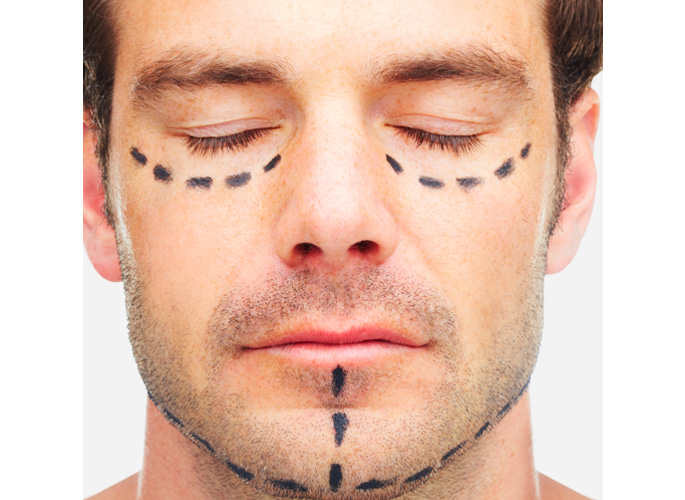Eyelid Lesions and Reconstruction
What are Eyelid Lesions?
Eyelid lesions include both benign and cancerous growths that form on the eyelid. This could include benign lesions such as:
- Cysts
- Skin tags
- Nevi (moles)
- Papillomas
- And others
However, cancerous growths and skin cancers can also form on the eyelid including:
- Basal cell carcinoma
- Squamous cell carcinoma
- Sebaceous carcinoma
- Malignant melanoma
- And others
How can I tell if the lesion is benign or cancerous?
Certain factors make a lesion more likely to be benign such as:
- Presence over a long period of time
- Lack of growth
- History of prior skin cancers
- Fair skin with significant sun exposure
- Growth in size over time
- Bleeding and crusting
- Loss of eyelashes
- Gradual misdirection of eyelashes
- Notching of the eyelid margin
- Irregular borders
The best way to make a definitive diagnosis is to perform a biopsy of the lesion and send it to pathology.
How does an eyelid lesion excision/biopsy work?
Normally, if a lesion looks benign, we will often excise the entire lesion (excisional biopsy) and send it to pathology. If a lesion looks potentially cancerous, we typically take only a portion of the lesion and send this to pathology (incisional biopsy).
Dr. Lee can perform the eyelid lesion excision or biopsy in the clinic. Local anesthetic is injected to numb the eyelid. The biopsy is performed and the specimen sent to pathology. A small amount of cautery may be applied to stop any bleeding. In most cases, no sutures are necessary as the defect heals up nicely on its own over the course of a couple weeks. The whole process typically takes about 15 minutes.
What if Pathology Shows that I Have an Eyelid Cancer?
If the pathology turns out to be cancerous, we coordinate with a skin cancer surgeon (Mohs surgeon). The Mohs surgeon will clear the margins of the cancer while trying to minimize the size of the final defect. A patch is placed over the site.
Patients then go to see Dr. Lee who will reconstruct the eyelid either the same day or the next day. The surgery usually takes place in a surgery center with local anesthetic and IV sedation. With smaller defects, Dr. Lee can close the defect directly. With larger defects, Dr. Lee may shift surrounding tissues to close the defect. In some cases, a skin graft may be used to help with the reconstruction. Eyelid reconstruction can take anywhere from 15 minutes to 1.5 hours depending on the type of reconstruction needed. When everything is healed, it is often very difficult to tell that any surgery was ever done.

Testimonials




What are the alternatives to surgery for eyelid skin cancers?
Surgical excision is the gold standard for treating skin cancers of the eyelid.
If patients are extremely sick and simply unable to have surgery, radiation treatment may be an option. However, radiation on the eyelid can cause other side effects such as dry eyes, cataract formation, and risk of forming new skin cancers.
Some skin cancers are extremely aggressive and cannot be cured by surgery. In some cases, chemotherapy may be an option to help treat these cancers.
What happens if I delay treatment for an eyelid skin cancer?
Most eyelid skin cancers are very slow growing, and we normally recommend having them treated with surgery within 2-3 months. Because cancers grow larger over time, waiting for longer periods of time can make the eventual Mohs surgery defect larger and the eyelid reconstruction more complex.
If left untreated for long periods of time, skin cancers of the eyelid can sometimes invade the eye socket or even metastasize throughout the body. If this happens, the cancer may be incurable or removal of the cancer may require removal of the eye and tissues around the eye.
How can I help prevent Skin Cancers of the Eyelid?
The sun is very strong in Hawaii and our nice weather allows us to spend lots of time outdoors (exposed to the sun). Patients can help avoid sun damage, skin cancers, and premature skin aging by doing the following:
- Wear sunglasses to protect the eyelids and periocular region
- Apply sunscreen
- Wear hats and protective clothing
- Avoid tanning
- Avoid sun exposure during peak daylight hours
Cancer-causing UV rays can penetrate glass and are especially strong at the beach and on the ocean. Even if you are not in direct sunlight, you can still be exposed to significant UV rays.
Does insurance cover eyelid lesion removal and biopsies?
Insurance typically covers the removal or biopsy of lesions that are growing in size, suspicious for cancer, or are causing irritation of the eyes or eyelids.
If lesions are cosmetically bothersome but are not worrisome for cancer or touching the eye, insurance may consider this cosmetic and not cover removal of the lesion.
What is the “down time” after eyelid lesion removal/biopsy and eyelid reconstruction?
The eyelid lesion removal/biopsy is a minor procedure done in the office, but patients can sometimes have some mild bruising and swelling of the eyelid for the first week. The defect usually heals and closes beautifully over the first two weeks. There is minimal pain after the procedure and no major activity restrictions. Patients can apply some ice to help with minor swelling. Antibiotic ointment should be placed on the biopsy site 2x/day for 1-2 weeks.
If you are undergoing Mohs surgery with eyelid reconstruction, there is again minimal pain after surgery. Most patients simply use ice and Tylenol for any discomfort. In some cases, Dr. Lee may apply a patch over the eye for the first week. Otherwise, the eye will be open although the vision may be slightly blurry for a few days. Patients can walk around the same day of surgery and do light activities, including using the computer or watching TV. They should avoid heavy lifting, straining, or bending for the first 2 weeks. Antibiotic ointment is applied to the incisions for the first two weeks. The sutures typically dissolve on their own.
Schedule Your Consultation Today
If you have an eyelid lesion or possible skin cancer, please don’t wait as cancers will continue to grow and can be more challenging to treat over time. Schedule your consultation today to help get answers about your eyelid lesion and how to properly manage it.


